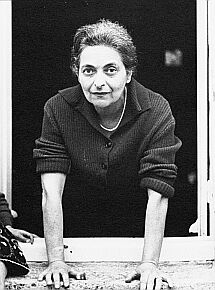Maria Helena VIERA DA SILVA
| Painter of the Ecole de Paris, leading figure of « abstract landscapes » |
Lisbon, 1908 – Paris 1992
We open our collection and our pages to the works of Vieira da Silva, to the beauty of her proposals, to the signs of a rare freedom that she discreetly addresses to us, and finally to her techniques.
From her proposals, we retain her reversal of the elements of the world, sensed not from here, from our lighting, but from within them, or from an inside that would look at them to assure us that indeed and in concert, they are looking at us.
Da Silva has engraved extensively, with precision, burin, aquatint… His lithographs, in particular, seem to transcend the paintings that precede them, seeming to find in them confirmation of their recommencements.
Then there are his chemins vicinaux, mosaics and children’s books in particular, such as Kô & Kô les deux esquimaux, published in 1933 by Galerie Jeanne-Bucher, where such freedom shines through!
This artist’s landscapes are multi-faceted, allowing us to glimpse their combinations. So it’s with pleasure that we enter.
Elements of a biography
- 1919 | Begins training at the Lisbon School of Fine Arts, drawing and painting section.
- 1928-30 | Moves to Paris. Studies at the Grande Chaumière, under Fernand Léger (painting), Antoine Bourdelle (sculpture), Stanley Hayter and Johnny Friedlaender (engraving). First solo exhibition.
- 1947 | After stays in Lisbon and Brazil, settles permanently in Paris, and from
- 1951 | paints several major works, including « Intérieur rouge », in which the chromatic simplifications of post-Cubism and azulejos converge, under the decisive influence of the work of Paul Cézanne.
- 1958 | Acquires international renown.
Main exhibitions
- 1932 | Gallery owner Jeanne Bucher sells one of his works to the Museum of Modern Art in New York. The following year, organizes his first solo exhibition.
- 1950-57 | Exhibitions: galerie-librairie La Hune, Paris; galerie Blanche, Stockholm.
- 1958 | First retrospective, Kestner Gesellschaft, Hanover, Germany, then Kunsthalle, Bremen.
- 1961-1969 | São Paulo Biennale. Knoedler Gallery (Guy Weelen catalog), New York. Phillips Art Gallery, Washington DC
- 1970 | Retrospectives, Musée National d’Art Moderne, Paris; then, in 1977, Musée d’Art Moderne de la Ville de Paris.
- 1988-1991 | Grand Palais, Paris. Solo exhibition. Retrospectives: Gulbenkian Museum, Lisbon. Then Juan March Foundation, Madrid.
- 1991-2005 | Presence in major collections: Museum of Modern Art, New York. Solomon R. Guggenheim Museum, New York. Tate, London. Stedelijk Museum, Amsterdam. Center Georges Pompidou, Paris.
- 2006 | Musée du Luxembourg (Sénat), Paris, featuring « La Ville de Sindbâd »,
- 1950 | « The Port », 1953 (from the Cologne Museum). « Composition 1955 ».
- 2022 | Musée Cantini, Marseille. « Vieira da Silva, l’oeil du labyrinthe ».
Four-handed works
- René Char – L’Inclémence lointaine. 25 burins. Pierre Berès éditeur, 1961. Exhibitions: New York, Washington, Gravura Gallery, Lisbon, then Bezalel Museum, Jerusalem, 1963.
- Plato – The Banquet (translation by Pierre Boutang). Hermann ed., Paris, 1972.
- André Malraux – The Coming One. An engraved portrait of the author. Editions Stock, 1974.
- René Char – Seven portraits. 7 aquatints in sugar drawn by Claude Manesse ed.
Léopold Sédar Senghor – Elegy for Philippe-Maguilen Senghor (…). 3 engravings. Jeanne Bucher ed. 1986.


